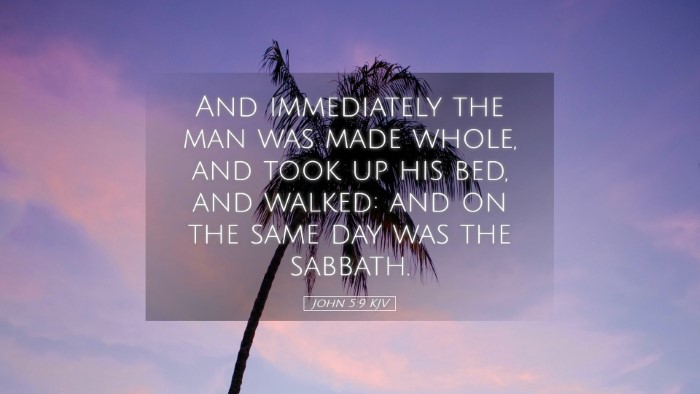Commentary on John 5:9
Verse Context: John 5:9 states: "And immediately the man was made whole, and took up his bed, and walked: and on the same day was the sabbath." This verse occurs in the narrative of Jesus healing a paralytic at the pool of Bethesda, demonstrating His authority and the nature of His work.
Summary of Insights from Public Domain Commentaries
1. Immediate Healing and the Authority of Christ
The instantaneous nature of the healing is profound and signifies the authority of Jesus. Matthew Henry comments that the man "was made whole" not just physically but spiritually, highlighting the completeness of Christ's work. His ability to heal correlates with His divine power, emphasizing that He is not hindered by physical limitations or man-made laws.
Albert Barnes further elucidates this by stating that the phrase "took up his bed" indicates a transformation; the once paralyzed man is now empowered to carry what had once been a burden. This act symbolizes the restoration of autonomy and the transformative power that Jesus brings into the lives of those He heals.
2. The Significance of the Sabbath
John purposefully mentions that this miracle occurred on the Sabbath, which becomes a focal point for the ensuing conflict between Jesus and religious authorities. Adam Clarke emphasizes that Jewish tradition had become overly rigid concerning the Sabbath, often prioritizing tradition over the well-being of individuals. Jesus, however, demonstrates that true Sabbath observance should reflect the compassion and healing nature of God.
Further, this incident serves as a critique of the legalistic interpretations of the law. Barnes notes that while the law prescribed rest, it did not intend to prohibit acts of mercy. Thus, Christ's healing on the Sabbath serves as a manifestation of true sabbatical rest—rest that brings wholeness rather than mere cessation of work.
3. The Role of Faith and Response
The healing of the paralytic also presents insights into faith and response. Although the man's faith is not overtly emphasized in the text, Clarke notes that the command of Jesus to "rise" required a response. The man's obedience symbolizes a step of faith; he acts on Christ's word, which is foundational in Christian discipleship—responding to the call of Jesus in the face of impossibility.
This response to Christ's command highlights a thematic element throughout the Gospel of John: the interplay between divine initiative and human response. Henry notes that true faith is often demonstrated through action, and this man exemplifies that principle by taking up his bed.
4. A Metaphor for Spiritual Healing
John 5:9 not only recounts a physical healing but also serves as a metaphor for spiritual healing. Henry insinuates that the physical actions of the man reflect a deeper spiritual truth—one of carrying the burdens of sin and emerging whole through faith in Christ. The act of walking symbolizes a new life, or spiritual vitality, which echoes throughout the New Testament.
Barnes adds that the man’s physical condition mirrors the condition of humanity—paralyzed by sin and unable to help itself until Christ intervenes. Thus, this narrative invites readers to consider their own need for healing and the transformative power of Jesus' words.
5. The Implications for Christian Practice
The ramifications of Jesus’ actions on the Sabbath serve as a critical reference in Christian practice. The notion of mercy over sacrifice (Hosea 6:6) resonates deeply within the Christian tradition and invites modern believers to reconsider the role of compassion in our observance of religious practices.
Henry emphasizes that Christians are commanded to reflect Christ's compassion in their own practices of faith. Thus, when we gather on the Sabbath or any day of worship, the focus should be on healing, restoration, and the love of God rather than mere ritual.
Additionally, Clarke warns against the dangers of rigid legalism that stifles spiritual growth and community. The teachings of Jesus advocate for joy and liberation through faith, urging Christians to embody this in their interactions with others.
Conclusion
In examining John 5:9 through the lenses of public domain commentaries, we gain a rich understanding of the text's implications regarding the authority of Christ, the liberation from legalism, and the transformative power of faith. This narrative challenges believers to rise from spiritual paralysis, embrace the healing offered by Jesus, and act in faith, reflecting God's love and mercy in every aspect of life.


